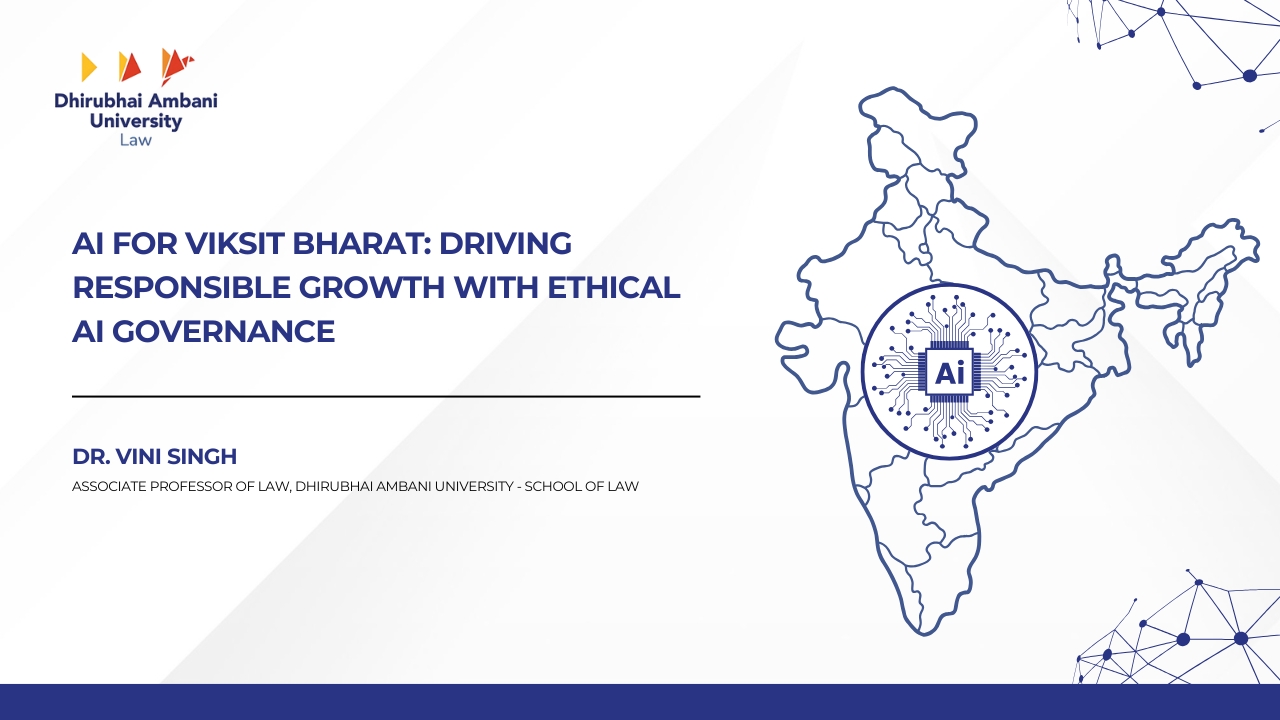
Introduction
In India’s fast-evolving landscape of Artificial Intelligence (AI) governance, 2025 has been a landmark year marked by multiple significant initiatives. Among these are two recent and particularly influential documents: the AI Vision document for Viksit Bharat, launched by NITI Aayog, and the AI Governance Framework for India 2025-26, published by the National Cyber and AI Centre (NCAIC). These foundational frameworks, released amidst a flurry of developments in AI policy this year, collectively set a comprehensive and strategic course for AI-driven growth and responsible governance in India.
By situating innovation and inclusivity alongside rigorous governance and legal compliance, these documents embody India’s nuanced, mature approach to harnessing AI’s potential while safeguarding ethical, social, and legal values.
NITI Aayog’s AI Vision for Viksit Bharat: Accelerated Economic Growth
NITI Aayog’s AI Vision document, “AI for Viksit Bharat: The Opportunity for Accelerated Economic Growth,” published in September 2025, builds on previous strategies like the 2018 National Strategy on Artificial Intelligence but introduces sharper economic forecasts and actionable sectoral pathways explicitly designed to push India’s GDP to an unprecedented $8.3 trillion by 2035. This would represent an 8% growth rate, outperforming the baseline trajectory by leveraging large-scale AI adoption and frontier innovation. It encourages inclusive and responsible adoption of AI so that India can become a global leader in nurturing innovation.
Key Takeaways:
- Accelerated AI Adoption to Bridge Growth Gaps: Targeted AI deployment in banking, manufacturing, healthcare, and automotive sectors aims to close 30-35% of India’s projected economic growth gap. For instance, AI-powered credit risk analytics and fraud detection in banking alone could add $50-55 billion to GDP by 2035.
- R&D Transformation via AI:Cutting-edge AI technologies such as generative AI are expected to unlock 20-30% of economic uplift through accelerated drug discovery, autonomous vehicle development, and more innovative manufacturing processes.
- Technology Infrastructure and Services Innovation:The vision promotes robust sovereign AI compute infrastructure, data ecosystems certified for anonymisation and interoperability, and an emphasis on open-source AI models to nurture startups and MSMEs, which will contribute 15-20% of the anticipated GDP gains.
- Data Sovereignty and Digital Public Goods: The report posits that India’s strength is in its data, which has the potential to transform India into the “data capital of the world.” This goal can be achieved by nurturing high-quality, accessible, interoperable datasets, developing specialised data platforms for specific sectors, creating an AI repository, and integrating AI with India’s Digital Public Infrastructure. These digital public goods, governed by strong privacy and ethical principles, will form the foundation for trusted AI applications, enabling innovation while protecting citizen rights.
- Workforce Transition and AI Skilling: The report suggests creating an expansive AI reskilling ecosystem for senior executives and upskilling the broader workforce with National AI certification programs, Cross-disciplinary university AI chairs, Industry-led skilling partnerships, accessible learning platforms, and a focus on transition supports for those vulnerable to automation displacement to ensure inclusion and economic resilience.
- Inclusive Impact and Multi-Stakeholder Collaboration: Beyond macroeconomic projections, the vision document foregrounds inclusion, proposing partnerships across government layers, the private sector, and academia. It highlights innovations through the Frontier Tech Repository, showcasing over 200 AI applications addressing local needs and mobile-first strategies reaching underserved populations.
- Robust AI Governance Frameworks: The report emphasises a robust AI governance framework, including ethics guidelines and risk controls, for secure AI deployment. It recommends that initiatives be taken to educate the C–suite and Boards on AI governance, for instance, human–in–the–loop documentation and disclosures. It also considers how a supervisor entity could build capacity in AI oversight, model risk, audits etc. At the same time, it recommends AI literacy for financial consumers and workers for swift grievance redressal and building trust in AI technologies.
- Equitable access to AI resources and technologies: To ensure inclusive growth, the report suggests that equitable access to AI resources and technologies, particularly to MSMEs and economically underrepresented regions, is essential.
NCAIC’s AI Governance Framework for India: Implementing Responsible AI
Released in early September 2025, the AI Governance Framework for India 2025-26 by NCAIC serves as a complementary governance pillar to India’s ambitious economic AI vision. Coming amidst multiple 2025 AI governance efforts, including advisory groups and reports by MeitY. It provides a concrete, actionable architecture for effective AI oversight aligned with India’s legal-regulatory ecosystem, especially the Digital Personal Data Protection (DPDP) Act 2023. It contains a clear taxonomy for AI risk, provides a clear role-based structure for governance, discusses a complete set of controls that should apply throughout AI lifecycle and provides actionable roadmaps and templates.
Key Takeaways:
Precision in Risk-Based Governance
The framework’s three-tier AI Risk Taxonomy – Prohibited AI, High-Risk AI, and Low-Risk AI enables granular governance calibrated to risk profiles, helping avoid the pitfalls of broad-brush AI regulation. Prohibited uses include social scoring and surveillance activities that threaten privacy or dignity. At the same time, high-risk applications (such as biometric ID or critical infrastructure AI) must undergo strict compliance and continuous monitoring.
Institutionalizing Accountability
NCAIC mandates the appointment of a Chief AI Risk Officer (CARO) within organisations for AI ethics and regulatory compliance and the formation of an AI Risk and Ethics Committee (AIREC) to supervise all AI-related risk management and impact assessment processes. This governance layer instills responsibility internally and supports accountability escalation.
Lifecycle Governance Approach
A comprehensive framework ensures AI systems embed privacy, security, fairness, and human rights protections throughout their lifecycle—from design, data collection, model training, to deployment and ongoing monitoring. Use of documentation standards such as Model Cards and Algorithmic Impact and Performance Assessments (AIPIA) formalises transparency and auditability.
Actionable Implementation Roadmaps
To assist ministries and enterprises, the framework outlines phased actions—100-day quick wins to 24-month structural reforms—including training, standardized reporting, and governance infrastructure setup. This roadmap is practical, ensuring actionable integration rather than aspirational guidelines.
Harmonization with Legal and Regulatory Instruments
The framework aligns with DPDP Act 2023 and CERT-In directives to unify AI governance within India’s cybersecurity and data privacy landscapes, thus preventing policy fragmentation.
Ethical Guardrails and Social Justice
The document upholds core human-centric values by prohibiting AI applications that could infringe upon fundamental rights, exacerbate bias, or diminish societal trust. It demands independent human rights impact assessments and mandates bias mitigation strategies.
Contextualising These Developments in 2025’s AI Governance Landscape
It is important to emphasise that these two documents are recent highlights among a series of significant AI governance developments in India in 2025. Earlier in the year, the Ministry of Electronics and Information Technology (MeitY) released an AI Governance Guidelines Report following extensive public consultations, and various advisory groups under the Principal Scientific Adviser’s office have worked on risk inventories and governance principles.
Additionally, the Indian government is preparing a comprehensive Digital India Act, which is likely to absorb and supplement AI regulation alongside existing acts such as the IT Act 2000 and DPDP Act 2023. India is also gearing up for the India AI Impact Summit scheduled for February 2026, underscoring the government’s ongoing commitment to shaping AI governance thoughtfully.
Thus, the NITI Aayog AI Vision and NCAIC Governance Framework represent important latest milestones that consolidate India’s evolving dynamic AI regulatory architecture in 2025, providing a dual focus on growth and governance harmonized with changing global AI policy trends.
Key Takeaways from both Documents
| Dimension | NITI Aayog AI Vision for Viksit Bharat | NCAIC AI Governance Framework |
| Strategic Orientation | Economic acceleration via AI adoption and innovation | Robust risk-based governance ensuring responsible AI use |
| Economic Impact | $500-$600 billion GDP boost expected by 2035 via sectoral AI adoption | Enables sustainable AI growth ensuring user protections and trust |
| AI Risk Classification | Ethical guidelines; less granular risk distinctions | Detailed Prohibited, High-Risk, Low-Risk taxonomy |
| Institutional Governance | Multi-stakeholder partnerships driving innovation ecosystem | Internal AI governance roles: CARO and AI Risk & Ethics Committee |
| Data Policy | India as a data capital with trusted, interoperable data markets | Focus on provenance, privacy by design, and legal alignment |
| Workforce & Skills | National AI skilling and reskilling programs | Governance includes mandatory human rights impact assessments |
| Governance Tools & Templates | Sector-specific roadmaps, skilling frameworks | Standardized governance documents: Model Cards, AIPIA |
| Compliance Model | Multi-stakeholder accountability | Mandatory compliance, transparency, and monitoring |
| Ethical and Social Focus | Inclusive, responsible AI with emphasis on equitable access | Prohibits harmful AI uses; mandates bias mitigation and fairness |
| Implementation Approach | Ecosystem innovation with government and private sector collaboration | Structured phased roadmaps supporting organizational implementation |
| Legal Alignment | Complementary to broader IndiaAI Mission | Harmonized with DPDP Act 2023 and CERT-In cybersecurity directives |
| Inclusion & Diversity | Emphasis on MSMEs, underserved regions, equitable AI access | Ensures protection of fundamental rights and social justice |
Conclusion
Amidst a year rich with AI policy advancements, the NITI Aayog AI Vision for Viksit Bharat and the NCAIC AI Governance Framework stand out as recent, strategic cornerstones of India’s AI agenda. Together, they signal India’s confident stride towards becoming a global AI powerhouse, channelling AI to generate unprecedented economic value while safeguarding human dignity and democratic values through transparent, accountable governance.
This dual approach aligns with India’s digital ambition and positions the country as a model for responsible AI adoption on the world stage, fostering an inclusive, innovation-driven, and ethically sound AI-powered Viksit Bharat.
